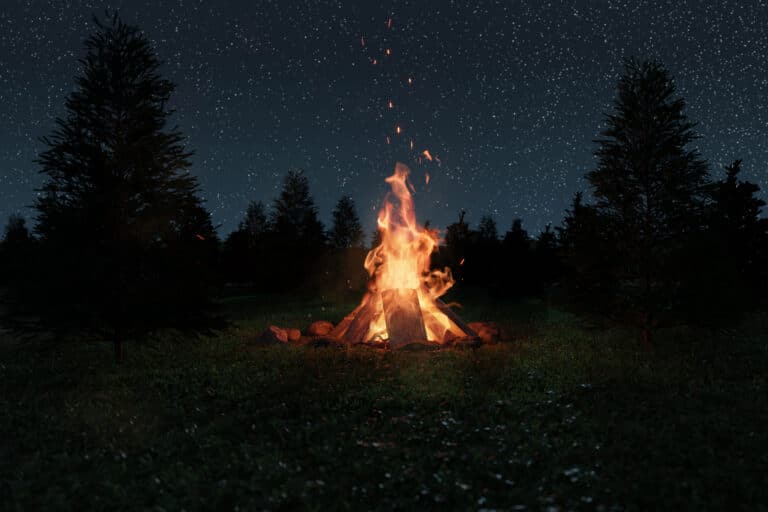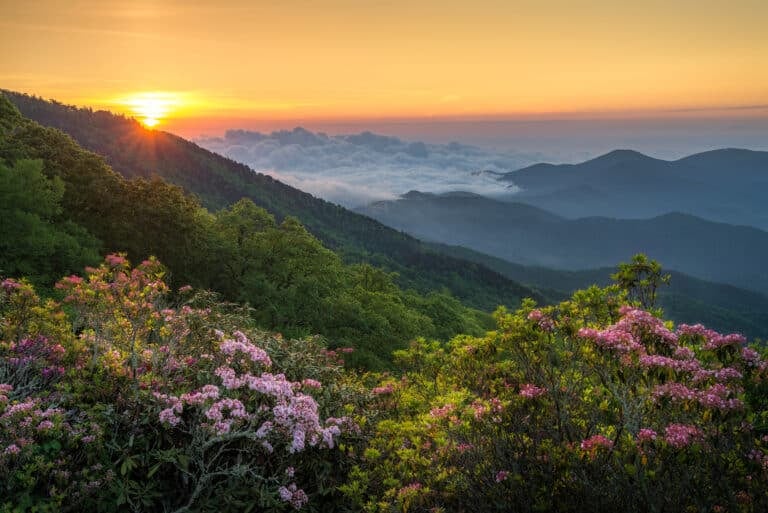by Cristina Opdahl
On an unseasonably warm day last October, I drove to Greenbrier County, West Virginia, where a controversial 124-turbine wind farm called Beech Ridge has been proposed. If built, it will be part of an important movement to develop forms of renewable energy to combat global warming and pollution. In the process, it will require windmills to be constructed along 23 miles of scenic ridgeline.

Because wind is most efficient and profitable where the wind blows hardest, wind farms in Appalachia are typically located atop ridgelines, where the wind picks up speed before it descends to the valley below. Because these prized ridgelines are highly scenic and highly visible, wind energy has become locally controversial.

But nearly everyone agrees that wind power is one of the cleanest forms of energy production—and also one of the most cost-effective. Once turbines are installed, they produce no carbon dioxide, mercury, or other nasty pollutants. One wind turbine working one year at a site with Class 4 wind speeds could displace 2.6 million pounds of carbon dioxide, 14,172 pounds of sulfur dioxide, and 8,688 pounds of nitrous oxides. 

The cost of wind energy has decreased by 85 percent in the last two decades, thanks in large part to tax incentives that help cut the enormous start-up expense. According to the National Resource Defense Council, at a cost of 4 to 6 cents per kilowatt-hour in 2002, wind energy was competitive with the costs of producing electricity by new coal- and gas-fired power plants. 

Wind power is now the fastest growing form of electricity generation in the United States. While currently the U.S. gets roughly 1 percent of its power from wind, the Department of Energy predicts the United States could produce at least 20 percent of its energy from wind.

Facts like these make Dave Buhrman’s post as spokesman for Mountain Communities for Responsible Energy (MCRE) a difficult one. Buhrman and MCRE oppose industrial wind energy—especially wind farms in the central Appalachians near Buhrman’s farm in Greenbrier County, West Virginia. He and his wife Rose moved to West Virginia from Richmond as back-to-the-landers in 1974. Buhrman’s thick salt-and-pepper mustache nearly covers his mouth, and his face is weathered from years laboring in his gardens. Buhrman grows vegetables on one acre right outside the weathered wood sided home he built himself. He has learned what to grow to sell to the nearby Greenbrier Resort and other local restaurants and grocery stores to make enough money to live comfortably here.

“The whole back-to-the-land movement that we embraced has to do with simplifying your lifestyle and reducing your consumption,” explains Buhrman. “So it seems to me tremendously ironic that those of us who simplified our lives and came to this beautiful natural world of the West Virginia mountains should have to endure industrialization by people hundreds of miles away—people who are still addicted to conspicuous consumption and need more electricity because they’ve got a three story foyer that they want to heat and air condition. The rich continue to do what they want, use as much energy as they want, and roll over everyone else.”

Buhrman responds to wind energy advocates with statistics of his own, like the fact that West Virginia is already exporting 70% of its coal, and the energy produced by Beech Ridge would not reduce any of the remaining 30 percent used in West Virginia, but go to neighboring states with renewable energy requirements. Plus, Greenbrier County’s 223 million tourism revenue could be jeopardized by industrial wind farms scarring the scenic landscape. 

But even Buhrman admits that a much more ugly demon lurks in the nearby mountains—mountaintop removal mining.

To extract the low-sulfur coal embedded in West Virginia’s mountains, coal companies have developed mountaintop removal mining—a brutal process where the top 1,000 feet of mountain tops are dynamited and removed. Coal River Mountain Watch, a Whitesville, West Virginia-based group, estimates that so far 400,000 acres of Appalachian Mountains have been demolished and over 8,000 miles of creeks have been buried and poisoned by mountaintop removal mining. 

The most common and obvious question posed to Buhrman and wind energy opponents is: “Aren’t a few windmills on the ridgelines better than removing the mountains and destroying communities?” 

Buhrman’s answer is well thought out. “If I thought that wind turbines being built in Greenbrier County would stop mountain top removal practices, then I’d start lobbying for the turbines. But I don’t think one is going to affect the other. I think both are indicative of the problem of huge powerful centralized corporations coming in like carpet baggers, like West Virginia has always had, and raping her resources and selling them cheaply to neighboring states.”

Instead of wind versus coal, Buhrman sees the debate as centralized industry versus small-scale energy production. Most wind farm critics like Buhrman insist that they are critics of industrial scale wind farms, not wind power. 

“It would make so much more sense to not be doing things on this huge industrial scale and doing it hundreds of miles from where the power is needed and then losing all of that energy in the process of transmitting it hundreds of miles,” says Buhrman. “It would make much more sense to have roof designs generating wind and generating solar right on the roofs of buildings, right where that building needs the power, right where the sky line has already been totally fractured by human involvement.” 

Buhrman, who is himself tied to the grid, was not politically active until 2005, when he and his neighbors heard that Invenergy, a Chicago-based company, was applying for a permit to install a wind farm along the mountain ridge that lies near their homes. Alarmed, they performed research and spoke with other groups that had opposed a wind farm in Tucker County in the northern mountains of West Virginia. They met with Invenergy and other community members. They formed MCRE to oppose the project. 

They built a case against the wind farm that included both local reasons and issues about wind power in general: the wind turbines proposed for Greenbrier County will be incredibly tall, with 262-foot tall bases and blades that will reach 388 feet at the highest point, and will create an eyesore for over 23 miles of ridgeline in the heavily touristed Greenbrier County. The turbines will also be visible in winter from many popular recreation points many miles away, including the Cranberry Wilderness, and lights on the turbines will cast an orange haze across an otherwise dark sky (Buhrman has recently started a night sky tour company with a new $10,000 telescope that sits on one of his dormant fields). 

To install wind turbines, large roads must be built on the mountains, fracturing the forest habitat. Deep holes have to be dug for each turbine foundation—“the equivalent of a hole big enough to fill four school buses standing on end,” says Buhrman—which will be filled with “something in the neighborhood of 500 cubic yards of concrete,” the curing of which emits carbon dioxide and could damage some of the local resident’s underground water sources. 

Even a giant wind farm like Beech Ridge won’t make much of a dent in the United States’ current gargantuan electricity usage, says Buhrman. Because the wind doesn’t constantly blow at high speed, even on ridgetops, even supporters caution that a wind farm’s electrical output is really only 30 percent of its capacity. In fact, even at its current rapid growth rate, wind energy won’t even offset increases in U.S. energy demands, and thus won’t dial back pollution as we need to. 

Then there is the danger turbines pose to birds and bats. Bats collide with turbines at a particularly high rate in Eastern mountain wind farms— Buhrman cites estimates of one per turbine per year. “When you start talking about 30,000 or 40,000 turbines, we’re significantly messing up the ecological balance,” he says. The rate of bird deaths is unknown, but he points out that wind turbines in the mountains tend to kill large raptors. 

Wind advocates counter that house cats, collisions with buildings, windows, vehicles, and communication towers claim many more birds than turbines. While it is not known how many birds perish due to air pollution, scientists have documented that the health of many species is clearly hampered by it. As a result, a majority of Audubon and bird groups in the East support wind energy that is carefully located and gives proper consideration to wildlife impacts.

What about Buhrman’s concerns about tourism? Companies that develop wind energy cite studies showing that wind farms have no effect on tourist areas. Dave Groberg, vice president at Invenergy and project manager for Beech Ridge Wind Farm, says that wind farms can actually have a positive impact on tourism. He adds, “This particular project is pretty far from typical tourist destinations in Greenbrier County. It’s 20 miles from the Greenbrier River, 15 miles from Lewisburg, and over 40 miles from the Cranberry Wilderness.” 

Groberg also points out that Beech Ridge is not pristine forest but private land owned by Westvaco, a timber and paper mill company. These mountains have a long history of mining and logging, and before the wind farm proposal, Groberg says, there were major clear cuts being planned. 

“This is not untouched forest, and that’s part of the reason we picked it,” says Groberg.

Buhrman still insists that Beech Ridge would be better off without wind turbines. “I’ve got several devils-advocate friends who said to me, ‘When was the last time you were on the top of those mountains? Westvaco has logged the hell out of them. There are broken bulldozers down there dripping hydraulic fluid right into the ground. There’s erosion and torn up roads and logging skids and everything else.’ To which I responded, ‘It still looks good from down here in the valley.’”

In November of 2005, Invenergy applied for a permit with the West Virginia Public Service Commission to build a wind farm that would include 124 turbines over 23 miles of ridge line. A public comment period followed, during which the commission received 2,671 letters opposed to the farm, and 685 letters in support of it. In spring of 2006, the public service commission voted to grant a siting certificate for all 124 turbines of the Beech Ridge wind farm. MCRE requested a reconsideration of their decision. In January of 2007, the West Virginia Public Service Commission reaffirmed their position in support of the Beech Ridge Wind Farm. MCRE filed a petition to appeal, this time to the West Virginia Supreme Court, and in April of 2007, the court agreed to hear their case. Briefs were filed this summer, but the case remains unscheduled. 

“We had hoped it would be this year but the court argument is pretty full,” says Groberg.





Another back-to-the-land environmentalist from the mountains believes wind farms are the best hope for the Appalachians. Avram Friedman was alarmed by the deadly smog choking the mountains near his home in Sylva, N.C. A former organic farmer with two decades of experience in small-scale alternative energy, Friedman quit his day job as a plumber in 2001 to form the Canary Coalition, a grassroots clean air advocacy group. Since then, the Canary Coalition has swelled to over 1,500 members, and it was instrumental in the passage of the North Carolina Clean Smokestacks Act, which required coal-fired power plants to reduce their emissions. 

Friedman says that the future of the Appalachians depends on reducing coal-fired energy, and wind energy is one of the best ways to accomplish that. 

“Right now ridgelines throughout the Appalachians are being inundated by acid rain from coal burning power plants. The emissions from coal-burning plants are deadly and far more destructive than anything associated with wind energy.”

Rather than seeing windmills as an eyesore, he views the spinning windmills as peaceful protectors of our mountains from far more serious threats.

“A wind farm marks a community as enlightened or forward-thinking. It’s a wise use of resources and an important part of the solution that ultimately protects the ridgetops from acid rain, ozone, mercury pollution and from climate change. A wind farm is a thing of beauty.” 

The view of the landscape, Friedman continues, is already marred by deadly smog and haze. “Air pollution and climate change are threatening entire species of birds, bats, animals and plants, and our human health is being seriously damaged. Childhood asthma rates are skyrocketing, and it’s no longer safe to breathe air for much of the year. We have to produce electricity in a different way than by burning coal.”

If there’s one thing Friedman and Buhrman agree on, it’s that energy conservation is essential to the Appalachia’s future.

“It takes a lot of windmills to produce the amount of energy of a coal burning power plant. But we have to look at it as part of a solution that includes a plan for using less energy,” says Friedman. “According to a recent report by the Intergovernmental Panel on Climate Change, we’re going to have to reduce greenhouse gas emissions by 80 to 90 percent over the next ten years to avoid the worst consequences of climate change. That means we’re going to have to use 60 to 80 percent less energy in general.” 





After returning home from my visit with Buhrman, I am torn. I find myself bringing up windmills in every conversation. “When I heard that some people were opposing wind farms, I thought, you’ve got to be kidding me!” says my brother-in-law from Fayetteville, who works in the recreation and tourism business. “You’ve got mountain top removal on the one hand and windmills on the other—what is the controversy?” He even visited a wind farm built in the northern part of the state. “Frankly I didn’t find them all that bad,” he says. “They’re kind of cool looking, really.”

“Hasn’t West Virginia given enough of itself to the country’s energy supply?” I counter. “Shouldn’t we start saying no, you know, protect our mountains?” In short, I’m holding up the Not In My Back Yard placard. It’s not a noble position. “Do it elsewhere, but just not here.” 

My husband, who has a knack for highlighting the stark contrasts in a debate, has been listening from the kitchen, and pipes up. “You’ve got coal fired power plants raining mercury down on us and emitting carbon dioxide into the atmosphere which is causing global warming and our doom, or windmills on our mountains. Which are you going to pick? The choice is basically between something ugly, and death. I’m just not going to say, ‘Well, sorry, I just can’t handle a wind farm. I choose death.’”

His argument smacks of hyperbole, but it’s right in line with the feelings of many other environmentalists. Robert F. Kennedy, Jr. was lambasted by many well-known greens in 2005 when he opposed a wind project in Cape Cod near the Kennedy family compound and published an op-ed stating so in The New York Times. More than 150 environmental advocates wrote him a letter asking him to change his position. “We are, simply put, in a state of ecological emergency,” they said. “Constructing windmills six miles from Cape Cod, where they will be visible as half-inch dots on the horizon is the least we can do.”

I fold my arms across my chest, and shake my head. Aesthetic concerns don’t really hold water against a state of emergency. Yet, if wind turbines are to be built throughout the Alleghenies, could they eventually become efficient enough to get rid of the polluting power plants? No one knows for sure. We’ve got to start somewhere, of course. The question we all face is: are we willing for that somewhere to be in our own backyard? •







